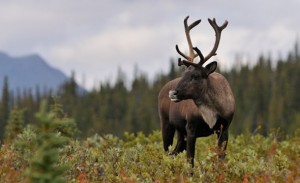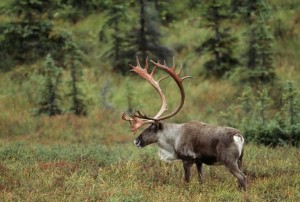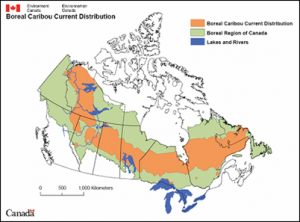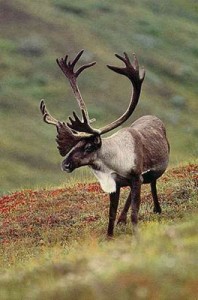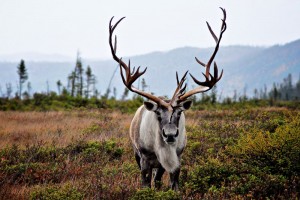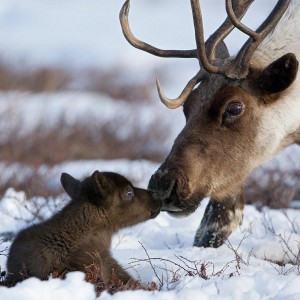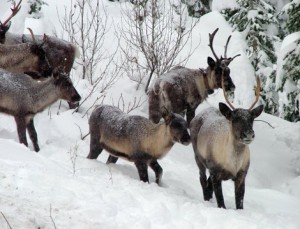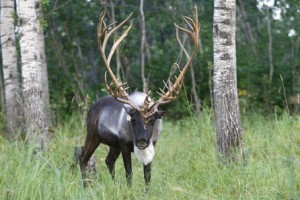Woodland Caribou
Woodland caribou or the boreal woodland caribou is the largest subspecies of caribou, a group of mammals belonging to the deer family. These medium-sized ungulates, native to the Northern United States and Canada, are characterized by a compact body with a thick covering of fur, short, wide ears, blunt muzzle, and a tiny tail.
The antlers of woodland caribou are broader, thicker, as well as more compact and flattened compared to those of barren-ground caribou, while their heads and legs are also longer than the latter.
Scientific Classification
| Kingdom | Animalia |
| Phylum | Chordata |
| Class | Mammalia |
| Order | Artiodactyla |
| Family | Cervidae |
| Genus | Rangifer |
| Species | R. tarandus |
| Scientific Name | Rangifer tarandus caribou |
Quick Information
| Other Names | Forest-dwelling caribou, woodland caribou (boreal group) |
| Size | Males are larger; the average height is 1.2m (4 ft) at the shoulder; length is 1.8m (6 ft) |
| Weight | 250-700 lbs (113-318 kg) |
| Color | Creamy white mane, neck, underbelly, shoulder; patches appear above the hooves; their coat is dark brown in summer, turning gray in winter |
| Distribution | The Selkirk Mountain Range covering eastern Washington, extreme northern Idaho, and British Columbia; Mackenzie River Delta region in Northwest Territories; Yukon, Alberta, Manitoba, Ontario, Saskatchewan, Newfoundland, and Labrador, and Quebec |
| Habitat | Boreal forests, mountains, and tundra areas; in winter, they are found in mature coniferous forests |
| Sounds | Female caribous are quite vocal when giving birth, as well as in early summer when they communicate with their calves; the males are heard only during mating season (rut), their vocalizations being less harsh than their female counterparts |
| Lifespan | May survive for up to 10-15 years in their natural habitat |
| Diet | Feed on both terrestrial and arboreal lichens; also eat small shrubs, dried sedges, leaves of willows, and flowering tundra plants |
| Adaptations | Large curved-sickle hooves of woodland caribou change shape in every season, facilitating them to walk in snow, swamps, and peats, as also to find ground lichens by digging through the snow; their keen sense of smell aids them in locating food beneath snow; the thick layer of hollow guard hairs minimizes loss of heat through the skin, as well as keeps them afloat in the water, making them excellent swimmers |
| Diseases and Parasites | Insects such as horseflies, warble flies, deer flies, black flies, mountain pine beetle, and mosquitoes are responsible for transmission of diseases; parasites including Echinococcus granulosus, Parelaphostrongylus andersoni, P. tenuis, and Elaphostrongylus rangiferi are some of the threats to woodland caribou |
| Weight at birth | About 13 lbs (6 kg) |
| Number of offsprings | One calf |
| Gestation Period | Around 230 days |
| Predators | Coyotes, lynx, cougar, wolves, and bears prey on boreal caribou, specifically the calves |
| Conservation Status |
|
| Why are woodland caribou endangered | Populations of woodland caribou have decreased due to human-induced destruction of habitats (influenced by constructions of roads, spread of mining and agriculture, forestry practices), predation, and hunting |
Behavior
These caribous do not live in large herds, and their groups remain scattered during mating season. Some woodland caribou populations migrate over short distances with the changing seasons, exhibiting elevational migration. They move up into the alpine mountain slopes during summer while forming isolated herds in the boreal forests during winter.
Some of them also adopt a unique survival strategy living in areas, which are unsuitable for elk and deer populations. Therefore, their habitat attracts a lesser number of wolves, bears, and lynxes, reducing the chances of predation on them.
Mating and Reproduction
As compared to some of the other species in the deer family, these caribous have a lower rate of reproduction. A male woodland caribou can mate with more than one female during their breeding season, which lasts from the end of September to mid-October. The male caribous with large antlers fight during rut for the mating rights. A female caribou of a boreal group gives birth to its calf and remains isolated from the other members of the herd until mid-winter. Thus, these solitary caribous are more likely to be preyed upon than those that migrate during the winter.
Life Cycle
The mother caribou gives birth to its offspring in early or mid-June. Weaning occurs around 2 months after birth, with the calves joining the rest of the herd during fall. Female caribous attain sexual maturity at 16 months while the males do the same at around 18 months. However, males do not mate until they are 3-4 years of age because of intrasexual selection.
Interesting Facts
- The graphic representation of woodland caribou on the opposite face of the 25-cent Canadian circulation coin, created by Emanuel Otto Hahn, first appeared on the quarter coins in 1937.
- Some mountain caribou herds, including the Leaf River and the George River herds, migrate thousands of miles north and south of their breeding range.
- Both the male and female woodland caribou are known to shed their old antlers and grow new ones every year. However, some females may not have them at all.
References
- https://defenders.org/wildlife/caribou
- https://wdfw.wa.gov/species-habitats/species/rangifer-tarandusf
- https://yukon.ca/en/woodland-caribou
- https://www.gov.nl.ca/ffa/wildlife/snp/programs/education/animal-facts/mammals/caribou/
Published on January 5th 2016 by admin under Coniferous Forest Animals.
Article was last reviewed on 5th December 2024.


